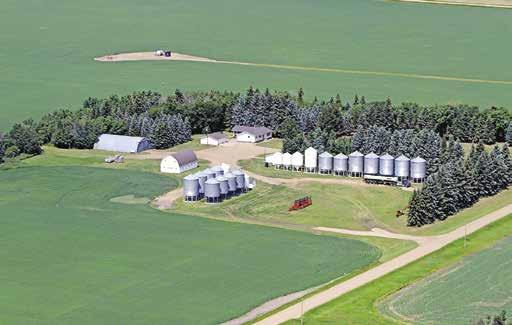The paper created EXCLUSIVELY for farm families and rural residents of east central Alberta
8 PAGES | APRIL 22, 2025

The paper created EXCLUSIVELY for farm families and rural residents of east central Alberta
8 PAGES | APRIL 22, 2025




In 4-H Beef Clubs, children and youth are taught practical skills that no textbook can, by raising calves from a young age. Every year, local kids pick out their calves and begin their journey. They feed them, monitor their growth, and train them to be calm and show ready. They deal with setbacks, celebrate small victories, and learn to care for a living creature rain or shine. The experience teaches more than just cattle care. These young ranchers learn time management, budgeting, animal health, marketing and the importance of being present and responsible. They track feed, monitor weight gain and prepare their animals for the sale. The Camrose district has seen growth in 4-H enrollment and this year, there are 70 steers available at the Show and Sale on June 3 at the Bashaw Agricultural Society Grounds.




























is published for Controlled Distribution By CAMROSE BOOSTER LTD. Blain Fowler, Publisher Circulation 11,639 copies
Providing coverage to the communities of Camrose (RRs and Boxes only), Ohaton, Edberg, Meeting Creek, Donalda, Bawlf, Kelsey, Rosalind, Daysland, Heisler, Strome, Forestburg, Galahad, Castor (farms), Killam, Sedgewick, Lougheed, Coronation/Brownfield, Alliance, Hardisty, Amisk, Hughenden, Czar, Metiskow, Cadogan, Provost (farms), Armena, Hay Lakes, New Sarepta, Round Hill, Kingman, Tofield, Ryley Holden, Bruce, Viking, Kinsella, Irma, Wainwright (farms and lock boxes), New Norway Ferintosh, Bashaw Bittern Lake, Gwynne, Stettler (farms).
Hours: Monday through Friday, 8 a.m. to 5 p.m.
Phone 780-672-3142 Fax 780-672-2518
News email: news@camrosebooster.com
Display Ads email: ads@camrosebooster.com
Classified Ads email: ads@camrosebooster.com Website: camrosebooster.com
4925-48 Street, Camrose, AB T4V 1L7
The most effective, most economical advertising medium in the Camrose area.
The entire contents of THE CAMROSE BOOSTER and THE COUNTRY BOOSTER are protected by copyright and any unauthorized reproduction of it, in whole or in part, without consent in writing, is expressly prohibited.

Submitted
Submitted
Battle River School Division is proud of recent BRSD student, Simone Doucet, who applied skills from BRSD’s Late French Immersion program to career potential and future learning.
Battle River School Division (BRSD) Late French Immersion program is designed for Grade 6 students who have a desire to learn French. The program is an excellent opportunity for students who are seeking an additional challenge and have a willingness to learn French in core subjects.
BRSD French Immersion and Late French Immersion programs use the French language in almost all subject areas. By completion of the program, students will find value in proficient French language skills for life-changing opportunities, extending beyond their time spent at BRSD.
Late French Immersion still starts early—in Grade 6—where students enrolled in the regular French Immersion program begin their studies in Kindergarten or Grade 1. When students begin in Late French Immersion, the goal is that these stu-
dents will join the other students—who started in the program by Grade 1— in high school.
Students in both programs have the opportunity to develop French language skills and become highly functional at communicating in both English and French by the end of Grade 12.
French Immersion is for you if you are seeking the opportunity to: Gain language proficiency in both English and French. Boost your business and career potential. Improve your confidence. Improve your problemsolving skills. Consider international study or national/international career opportunities such as the Foreign Service.
French Immersion opens doors to a world of possibilities. Recent BRSD graduate, Simone Doucet has since achieved French language proficiency certification, Diploma of French Language Studies (DELF or Diplôme d’Études en Langue Française) and shares how school experience provided a career foundation.
“The Late French Immersion program inspired me to want to study abroad in France, and so I applied
for the Rotary Club’s fantastic International Student Exchange program,” said Doucet. “I was successful in my application, and after living in Calais, France, for Grade 11, I passed my DELF exam and am officially bilingual.
“The intimate group of students and great teaching created an engaging classroom environment that encouraged us to thrive in Late French Immersion. Joining this program in Grade 6 was the start of a huge adventure for me, and I am extremely grateful I had this opportunity,” she continued.
BRSD is excited to provide its students with lifechanging opportunities. With the 2025-26 school year around the corner, families have started to register. BRSD looks forward to seeing new faces in its French Immersion programs in September. Note that parents of students in French Immersion do not need to speak French to support their child.
By Murray Green
The Jans family celebrated a century of farming in the New Norway area.
Camrose County recognized the Jans family with a plaque.
It started with Herman Jans coming to Canada prior to the First World War from Germany. He was sponsored by a gentleman named Ernest Reimer. Herman was able to find employment as a farm hand in the Rosebrier district. He met his wife Dorothea at the same farm, as she was also working for the same family. She was also from Germany. They were married in 1915.
They were able to purchase a farm in the Gwynne district. After three consecutive years of crop failure due to early frost, hail and drought, they lost this property. They had three children born on this farm, two daughters and a son, Katherine, Armien and Elsie. Herman’s brother Andrew and his family came from Germany and they were able to pool resources and purchase a farm near New Norway. There was a large two-storey house at this farm.
At that time, Herman had the home quarter, and an adjacent half section to

Submitted
The Jans family farm near New Norway has been in the family for more than 100 years.
the west and Andrew had a quarter to the southeast. The two families lived together for several years, and then Andrew and his family moved two miles away, where he acquired another farm site. Three more sons were born at the New Norway farmstead, Ernest, Henry and Joe. They all became farmers in the New Norway area. Ernest remained on the home farm.
Ernest tore down the old house, as it had a poor foundation, and moved a mobile home onto the yard site in 1973. He married Gwen Price from Forestburg and they farmed there until 1982, when he rented his land to his nephew Curtis. In 1984, he wanted to fully retire and sold the land to Curtis and moved
to Camrose.
Curtis attended ULC (Augustana) and U of A, where he played hockey with the Vikings and Golden Bears and obtained his B.Sc. in Agriculture in 1983. He had a job offer with a chemical company, but turned it down to become a full-time farmer. He bought half of the commercial cattle herd, two quarters of land (including the home quarter) and rented two more quarters from Ernest. Curtis farmed with his father, Joe Jans, who lived a few miles away, where Curtis grew up.
Curtis married Karen Bergquist from Bawlf in December 1984. Karen, a registered nurse, worked at St. Mary’s Hospital and helped on the farm. They raised three children on the farm. In 1988, the yard site was hit by a tornado and the mobile home, machine shed, several cattle sheds and the wind break sustained severe damage. The machine shed was torn down and rebuilt that summer. A new house was built in 1989. The wind break was brushed and new trees planted.
In the late 1980s, Curtis’ brothers, Dale and Blair, joined the farming operation, each acquiring their own land base.
By Murray Green
Camrose County had a good year of coming in under budget on several items and had a higher source of revenue in 2024 to incur a surplus of $2,840,000.
That money was transferred into several departments and projects to save for unexpected costs in the future.
“An operating surplus contributed to more cash for the County. The financial assets are just over $40 million (up from about $37 million in 2023) and the financial liabilities were more than $26 million (down from $27,077,529 in 2023). The long-term debt is $6,045,079, down from $9,222,844 in 2023, so the County is paying off their loans and debt,” explained Curtis Friesen, Metrix Group LLP accountant.
“When you are in a better position than you were last year, that is a positive statement,” said Friesen, about the audited financial statements.
“The main reason revenue is up is because of the West Dried Meat Lake Regional Landfill. The seed plant is also bringing in more money. In total, the 2024 revenue was $29,028,915 compared to $26,569,522 the year be-
fore. The expenses were up, mainly because of maintaining roads, streets, walks and lighting reaching $8,794,096. But, a surplus of $3.1 million is a healthy surplus. The County also has healthy investments.
About $6 million is in deferred revenue meaning the funds haven’t been received yet or have not been spent yet,” shared Friesen.
The County had a debt of $9,222,844 in 2023, now that amount is $6,045,079
due to paying off more on loans such as the seed cleaning plants in Camrose and Bashaw.
“At two per cent interest rates, those are pretty good rates,” added Friesen.
“I move that Camrose County council accept and approve the 2024 Year End Audited Financial Statement and authorize that it be made available to the public,” said councillor Carl Bergstrom.

Murray Green, Camrose Booster
Vision Credit Union assisted the Hay Lakes Fire Department with $2,500 in funds for new bunker gear through the Helping Hands fund. Fire department members, from left, Jesse These, Cord These and BJ Green represented the 25 members of the Hay Lakes Fire Department, while Vision Credit Union staff Sharon Nelson, Alyssa Phillips, Angela McCallum and Trudy Iftody presented the funds.
Submitted
On April 3, the Minister of Technology and Innovation, Nate Glubish, Minister of Service Alberta and Red Tape Reduction, Dale Nally, and the Minister of Energy and Minerals, Brian Jean joined local MLA Jackie Lovely for a gathering to hear about the work Minister Nally and his team have been focusing on for Albertans. Proposed changes to the Skilled Trades and Apprenticeship Education Act would clarify the legal responsibility and duties of trade unions, employers’ organizations, and occupational associations to the apprentices they sponsor. These changes would make it easier for apprentices and sponsors to access the program and ensure that apprentices around Alberta continue to receive quality on-the-job training. Proposed amendments to the Charitable Fundraising Act would reduce internal red tape, simplify delegation, administration and enforcement, and create consistency with other consumer protection legislation. Specifically, the changes allow the Minister to establish a Director of Charitable Fundraising with administrative and decision-making authorities as delegated. Proposed changes to the RTA would allow landlords and ten-

ants to use other forms of electronic communication, such as email, for serving documents (like eviction notices and rent increases). This form of communication would only apply when a landlord or tenant has been unable to serve documents through other methods, including registered mail, public posting of materials, or through a document service company. There were also more changes made to charities which came into effect on April 1: AGLC has added a wide range of proceeds categories, and raised thresholds for spending before approvals are required, giving charities wide discretion in determining eligible expenses. Examples
include: Groups can retain proceeds up to $50,000 without AGLC approval (previously $10,000), Charitable groups can now use $100,000 of gaming proceeds to conduct community events without AGLC approval. The limit for administrative expenses has increased to 30 per cent from 20 per cent. Approvals for all travel have been eliminated. The limit for facility renovations and leasehold improvements without approval has been increased to $100,000 from $50,000.
An Automatic Yes Toolkit has been introduced. Since the work to improve wait times for permit decisions across all Ministries began in 2023, nearly 20 per cent of government per-
mits have demonstrated an improvement in average wait times, with several permits seeing improvements by 30 days or more. Permitting delays and excessive red tape are interfering with growth and job creation across several industries, forcing businesses to spend valuable time navigating unnecessary bureaucracy instead. With our Automatic Yes toolkit in place, Alberta’s government has a tool to evaluate removing lowrisk, routine permits by setting clear operating rules and enforcing mandatory decision timelines for other permits. By enabling government to process simple permit applications quickly, we’re freeing up time for government staff to review
more complex permit applications and focus on monitoring and enforcement activities. Alberta’s government will not compromise important health, safety, and environmental protections, including the ability to deny permits when necessary and appropriate and this new toolkit keeps that balance. This is all part of our work to ensure that Alberta remains a top jurisdiction for business investment and growth.
The Automatic Yes Toolkit is based on policy approaches that have proven successful across jurisdictions in North America, and those already used to some degree, by the Government of Alberta. The three Automatic Yes approaches include Code of Practice (COP), Permitby-Rule (PBR), and Shot Clock. Each approach is suited to different levels of regulatory risk and permit complexity, ranging from low-risk activities that pose minimal harm to the environment and public health and safety, to medium-risk activities that may require more extensive review and oversight.
This Toolkit is not focused on activities categorized as higher risk or permit applications that require a more complex review and approval process.



















By Murray Green
The
“This
istrator Teresa Gratrix.
“Since
Camrose
“I
































The

















































By Murray Green
Residents of Bittern Lake made a decision to continue to operate as the Village of Bittern Lake.
A viability review was initiated for the Village of Bittern Lake in October 2023. This review started because of a sufficient petition.
Electors of the municipality voted on April 1 and April 2 to remain a village and implement changes to achieve viability.
A total of 119 people voted, with 66 in favour of staying a village and 53 voting to dissolve into a hamlet. The majority of votes cast at 55 per cent was enough to keep Bittern Lake a village.
As a result of the vote, the minister of municipal affairs may issue directives that the municipality must comply with to improve its viability. These directives will be based on the recommendations included in the viability review report.
An initial public information session was held in Bittern Lake to review the viability review process with the community on January 11, 2024. Based on this initial information session, an additional information document was prepared for the public.
A mid-review public information session was held in Bittern Lake on June 19, 2024, to provide an update on the viability review process and an opportunity to gather additional public input. A viability report was finalized in March 2025 and shared with the community at the local hall.
A pre-vote public information session was held in Bittern Lake on March 18, to review the contents of the updated report and answer questions about the report and the vote of electors. Alberta municipal affairs staff Sharlene Brown and Linda Reynolds explained the process at the Bittern Lake Community Hall at that meeting.
The options for voting were Option 1: The Village of Bittern Lake remains a village and implements changes to achieve viability. Option 2: Dissolve the Village of Bittern Lake and Bittern Lake becomes a hamlet in Camrose County.
Alberta municipal affairs staff Sharlene Brown and Linda Reynolds explained the process at the Bittern Lake Community Hall.
“Should electors vote to remain a municipality, the minister of municipal affairs will direct the village to take action to improve its viability,” said Brown, at that time.
Village council now has a mandate to develop a long-term strategic plan of 10 years, not just for five years and increase communications and engagement with the community to improve resident satisfaction.
Alberta municipal affairs determined a 10-year plan of repairing or replacing roads, water systems, storm water upgrades and sanitary system upgrades would cost more than $4 million at 2025 prices.
By
Murray Green Camrose County passed the final budget, which will see the average ratepayer living within the County to have an increase of approximately 2.27 per cent more in property taxes in 2025.
Tax levy increases in the 2025 budget are due to less provincial government funding and higher overall costs of doing business.
What does that mean for the average ratepayer?
This interim budget projects tax rate increases of five per cent for farmland (same as last year), three per cent for residential and linear (pipelines, power lines and wells 2024 increase was 3.5 per cent), and two per cent for nonresidential and M&E (Machinery and Equipment) 2024 increase was 3.25 per cent.
At the regular council meeting on April 8, administrator Teresa Gratrix presented the operating and capital budgets for council’s approval.
“I move that Camrose County council approve the final 2025 Operating Budget with a total operating revenue of $29,187,550, total operating expenses of $46,998,760 with a total Tax Levy of $17,811,210,” said councillor Doug Lyseng. Operating revenues and expenses have been adjusted by $1,229,271.
“Overall, this budget is very much a good news story. Notable items include: repayment of debt in the past couple years has freed up operating funds to decrease the reliance on property taxes and ease the impact of inflationary items in the County budget (utilities, fuel, insurance); economic development efforts are paying off with new developments in the County; increased grants to volunteer and community groups and libraries illustrate council’s commitment to making Camrose County a great place to live; the sale
of surplus property has reduced expenses, increased revenues and the proceeds are added to reserve; the use of grants for capital projects has made it possible for County reserves to be added to; equipment additions were funded in part by better than average returns on the disposal of the units being replaced,” explained County administrator Gratrix.
“Based on the final budget, the property tax increase on farmland taxes will be two per cent (2.18 per cent increase overall). Residential property will increase by 1.5 per cent, but 2.27 per cent increase overall. Non-residential, linear and M&E will all have a one per cent increase,” said Gratrix.
County council approved the 2025 final capital budget with total capital and project expenses of $10,339,264 to be funded by internal resources (sale of assets, grants, debentures or reserves) of $9,205,637 and a total capital levy of $1,133,627.
“Small capital projects totalling $380,029 were moved from the Interim Operating Budget to the Capital Budget. These items will be funding with LGFF Operating Grants. Two new items were added to this small capital list: utilities GIS program (this software will allow our utilities staff to more closely monitor the water and wastewater assets) $63,000 and radios (two were purchased last year and we had planned to move to four in 2026, but have decided to move ahead sooner) $20,000,” explained Gratrix.
The province has announced that the Education Tax rate will be increased significantly for Camrose County at 12 per cent for residential and farmland, and 10 per cent for nonresidential properties. This requisition increase is mitigated by the increased assessment for the County.


By Jackie Lovely, MLA Camrose Constituency
The safety and security of our communities are of highest importance and ensuring the protection of Alberta’s critical infrastructure is a key priority of this government.
Recently, I had the pleasure of welcoming minister Mike Ellis and minister Nate Horner to Hardisty for an engagement session with local stakeholders. This meeting was an important opportunity for our community to provide direct feedback to the ministers regarding the challenges we face and the actions needed to address them.
Thanks to these valuable discussions, our government has responded swiftly with proposed amendments to the Critical Infrastructure Defence Act, reinforcing our commitment to safeguarding Alberta’s economy and public safety.
Our government is taking swift action to protect our province’s essential infrastructure and enhance security measures under the Alberta Sovereignty Within a United Canada Act. The proposed amendments to the Critical Infrastructure Defence Act are intended to ensure that the officers have the necessary tools to effectively prevent unlawful interference with critical sites, particularly in high-risk areas like our border and energy sectors.
One of the key updates, is the expansion of the definition of essential infrastructure to include a twokilometre deep border zone north of the Alberta-United States border. This strategic addition will allow law enforcement to better protect against trespassing, interference, and damage that could have serious public safety, economic, and environmental effects. It is important to note that the act will only apply when individuals have no lawful right, justification, or excuse to be in the area. Those who are legally working, living, or travelling within this zone will not be impacted.



Additionally, the amendments are aimed to protect Alberta’s economy from harmful federal policies, such as the proposed emissions cap. By updating the Critical Infrastructure Defence Act to include facilities where oil and gas production and emission data and records are stored, we are taking proactive steps to defend Alberta’s energy sector. This is essential to maintaining our position as a responsible global energy producer while supporting economic growth and job creation across the province.
Our government is also taking a firm stance against federal overreach. The amendments will clearly state that the Critical Infrastructure Defence Act applies to the Government of Canada. This ensures that Alberta’s essential infrastructure remains under provincial jurisdiction and is protected from any regulatory actions that could compromise our province’s economic interests.
These proposed changes are not just about legal definitions, they are about ensuring that our officers, industry leaders and communities have the necessary tools to prevent disruptions that could impact our way of life. Whether it is our border security, energy facilities, or transportation networks, Alberta’s critical infrastructure plays a vital role in the success and safety of our province.
I am proud to stand alongside my colleagues in government as we work to protect Alberta’s interests. The feedback from our stakeholders in Hardisty has been instrumental in shaping these legislative updates. These amendments will help secure a strong and prosperous future for our province while reinforcing Alberta’s sovereignty within Canada.
If you have any questions or concerns, contact my office. We are always here for you!
You can contact Jackie Lovely, Camrose MLA, at Constituency Office, 104, 4870-51 Street, Camrose, AB T4V 1S1. Tel: 780-672-0000, camrose@assembly.ab.ca or at Legislature Office, 6th Floor, 9820-107 Street, Edmonton, AB T5K 1E7.






By Adan Shaikh
Hospice Society of Camrose and District (HSCD) is hosting a symposium for families and individuals facing end-of-life. The discussion will be hosted on May 8 in the auditorium at the Mirror Lake Centre located at 5415-49 Avenue.
This symposium is open to professionals, volunteers, caregivers and the general public. The event will begin at 9 a.m. with the keynote speaker Jeremy Allen. Allen is a funeral director in Provost and will discuss the topic of death and how to lean into the difficult conversations around it.
“Part of our mission here at Hospice is to provide education, to help people and their families prepare to cope with death. The goal of the symposium is to share that. Jeremy Allen is a great speaker and he focuses on providing knowledge on how people can better cope with situations while being compassionate and present,” shared Sharon Burden, board member of HSCD and chair of the symposium committee.
The afternoon panel will have five guest speakers, who will go over different aspects of grief, death, and legalities to help people prepare for end-of-life.
“On the panel, we have Eric Barstad, who is a lawyer, he will provide education about wills, personal directives and power of attorney, so when there is a death it is not so overwhelming. It is also a good way that people can let their wishes be known, because quite often people struggle to have that conversation with their families,” said Sharon.
“Then we have Dustin, who is a financial advisor, and he will also talk about some of the things you can do to financially prepare ahead of time, and a little bit about estate planning,” she continued.
“Bart Orr is going to talk about pre-planning a funeral, and then Tyler Weber, who is also a funeral director, will talk about what are some of the first things you need to do after the funeral,” commented Sharon.
The symposium will not only focus on coping with death but also provide resources for family and friends of those who are facing end-of-life to prepare for what comes next. Often after losing a loved one, individuals can face financial burdens and a large amount of paperwork. The speakers will help the participants pre-





































pare ahead of time for those situations so they can focus on processing through their grief and not be overwhelmed by the decisions and paperwork.
“Caregivers Alberta is going to review what kind of resources they have available to help individuals in rural Alberta. Then all of these participants will have a display table where they can share some of their work and information with the participants,” shared Pam Cummer, vicepresident of the HSCD board. The event will include morning coffee/tea and snack and a hot lunch in the afternoon with more tea/ coffee available throughout the event. To register and get tickets for the event contact 780-608-0636 or email admin@camrosehospice.com.
Submitted
Christian Health Association of Alberta (CHAA) joined MLA Jackie Lovely and other MLAs at the Alberta Legislature on March 27 to showcase the history and depth of CHAA’s health care and continuing care/assisted living services for seniors and vulnerable populations across Alberta.
With roots dating back to the mid1800s in rural Alberta, CHAA’s 13 member organizations are often considered the province’s first health care system, starting out as nursing care delivered inside rural churches and schools.
At present, CHAA operates more than 175 facilities and serves 35,000 Albertans in all streams of housing and
health care, including subsidized housing and lodges, home care, supportive living, acute care, long-term care, palliative and end-of-life care, and complex geriatric and mental health programming.
Association members thanked the Government of Alberta for the highly collaborative relationship over the past one and a half centuries acknowledging the 22,000 staff and volunteers who continue to serve seniors across a range of housing and health care needs.
The role of CHAA’s trusted, non-profit, faith-based members will continue to drive innovation and resident-centred care during transformation of the health care system.